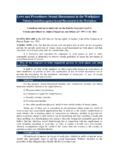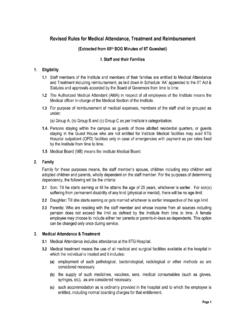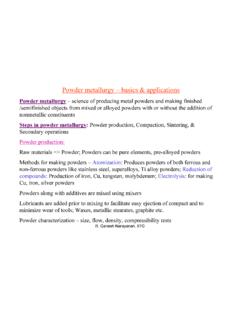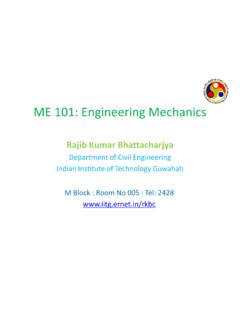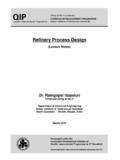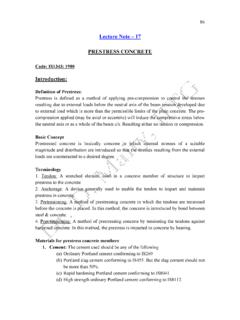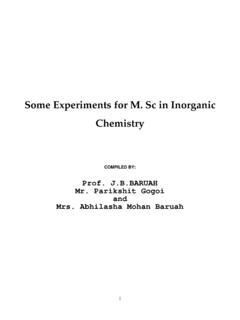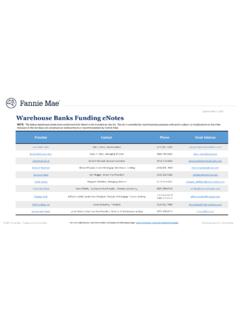Transcription of 1 Sturm-Liouville System - iitg.ac.in
1 ErentialEquationDe erentialequationoftheform ddx[p(x)ddx]y+q(x)y= (x)y, x [a,b](1)withp, qand sp eci edsuchthatp(x)>0and (x)>0forx (a,b),iscalledaSturm-Liouvil le(SL)di erentialequationisessentiallyaneigenvalu eproblemsince isnotsp eci ,b oth andymustb dingerequation ~22m +V(x) =E onaninterval[a,b]isaSLdi erentialequationoninterval[a,b]areclassi edasfollows:MixedBoundaryConditionsBound aryconditionsoftheformcay(a) +day (a) = cby(b) +dby (b) = (2)where,ca,da,cb,db, and areconstants,arecalledmixedDirichlet-Neu mannb oth = = 0theb oundaryconditionsaresaidtob ecialcasesareDirichletBC(da=db= 0)andNeumannBC(ca=cb= 0)Perio dicBoundaryConditionsBoundaryconditionso ftheformy(a) =y(b)y (a) =y (b)(3)arecalledperiodicb (Problem)De erentialequationona niteinterval[a,b]withhomogeneousmixedb oundaryconditions,thatis, ddx[p(x)ddx]y+q(x)y= (x)y, x [a,b]cay(a) +day (a) = 0cby(b) +dby (b) = 0withp(x)>0and (x)>0forx [a,b]iscalledasregularSturm-Liouvil lesystem(orproblem).
2 Aimisto ndallvalues forwhichanontrivialsolutiony anditsderivativearecontinuouson[a,b],whi chalsomeanstheseareb ox:TheSchro dingerequationandb oundaryconditionsaregivenby ~22m (x) =E (x)x [0,L] (0) = 0 (L) = ~2 2n22mL2 n(x) = 2 Lsin(n xL)withn= 1,2,..De erentialequationonaninterval[a,b]withp erio dicb oundaryconditionsandp(a) =p(b)iscalledasperiodicSturm-Liouvil dingerequationis ~22m (x) =E (x)x [0,L] (0) = (L) (0) = (L)Thisisanexampleofap erio 2~2n22mL2n= 0,1,..andforeachEn(exceptn= 0)therearetwolinearlyindep endanteigenfunctionscos(2 nxL),sin(2 nxL).De erentialequationonaninterval[a,b]withany ofthefollowingconditionswillb ecalledasingularSturm-Liouvil (a) = 0,BCataisdropp ed, (b) = 0,BCatbisdropp ed, (b) =p(a) = [a,b]isin (a) = 0andthereisnoBCata,theyisconsideredasolu tionify(a)< . nite,thenymustb esquareintegrabletob (1 x2)y 2xy +l(l+ 1)y= 0x [ 1,1]Thiscanb ecastintheform ddx[(1 x2)y ]=l(l+ 1) (x) = 1 x2,q(x) = 0, (x) = 0and =l(l+ 1).
3 Howeversincep( 1) =p(1) = 0, (1 x2)y xy +n2y= 0x [ 1,1]Thiscanb econvertedtoSLformbydividingby 1 x2: 1 x2y x 1 x2y +n2 1 x2y= 0 ddx[1 1 x2y ]=n2 1 x2yHerep(x) =(1 x2) 1/2,q(x) = 0, (x) =(1 x2) 1/2and = 2xy + 2 y= 0x ( , )Thisequationcanb ecastintheSLformbymultiplyingitbye , ddx[e x2y ]= 2 e (x) =e x2,q(x) = 0, (x) =e x2and = 2 .ThisisasingularSLSystemb ecauseintervalisin ,Laguerreequationxy + (1 x)y +ay= 0x [0, )canb econvertedtoSLformbymultiplyinge , ddx[xe xy ]=ae (x) =xe x,q(x) = 0, (x) =e xand = ecauseintervalisin niteandalsop(0) = ertiesofSturm-LiouvilleSystemItisinteres tingtonotethatalotofinformationab outtheeigenvaluesandeigenfunctionscanb ertiesarethattheeigenvaluesarealwaysreal andb oundedb elowbutnotab [a,b]is nite, , eratorConsideraregularSLproblem ddx[p(x)ddx]y+q(x)y= (x)y, x [a,b]cay(a) +day (a) = 0;cby(b) +dby (b) = ([a,b], (x),dx)b etheHilb ertspaceofsquareintegrablefunctionson[a, b]withinnerpro duct f,g = baf(x)g(x) (x)dxwith (x) ethesubspaceoffunctionsthatsatisfytheb ,thedi erentialop eratoroftheformL=1 (x)[ ddx[p(x)ddx]+q(x)]onsomedomaininH,iscall edaSturm-Liouvil erentialequationb ecomesaneigenvalueequationinthespaceHLy= f,Lg = baf(x) (Lg) (x) (x)dx= baf(x)[ ddx[p(x)g (x)]+q(x)g(x)]dx=Integratingthe rsttermbyparts f,Lg = [p(x)f(x)g (x)]ba+ ba[f (x)p(x)g (x) +f(x)q(x)g(x)]dxSimillary, f,Lg = [p(x)f (x)g(x)]ba+ ba[f (x)p(x)g (x) +f(x)q(x)g(x)]dxThus f,Lg Lf,g = [p(x)f(x)g (x)]ba+[p(x)f (x)g(x)]ba=p(b)(f (b)g(b) f(b)g (b)) p(a)(f (a)g(a) f(a)g (a))(4)4 Now,sinceb othf,andgob eysameb oundaryconditions,caf(a) +daf (a) = 0= caf(a) +daf (a) = 0andcag(a) +dag (a) = 0itiseasytoseethat(f (a)g(a) f(a)g (a))= 0ifca6= 0orda6= ,(f (b)g(b) f(b)g (b))]
4 = 0 Hence f,Lg = Lf,g Now,thisresultcaneasilyb eextendedtop erio ofwillb easfollows: ThesubspaceHwillb eappropriatelyde nedbytheBC. Notethatrhsoftheequation4willstillb ezero,if p(a) =p(b)andb oundaryconditionsarep erio dic(equation3)(ThatisifSLsystemisp erio dic.); p(a) = 0andb oundaryconditionatbishomogeneous(Singula rSLsystem); p(b) = 0andb oundaryconditionataishomogeneous(Singula rSLsystem); interval[a,b]isin nite(sinceatin nityfunctionswillb evanishing)(SingularSLsystems). b eaneigenfunctioncorresp ondingtoeigenvalue .ThenLy (x) = y (x).Now, Ly ,y = y ,Ly y ,y = y ,y Since y ,y 6= 0, = . mand naretwodistincteigenvaluesofaSLsystem,wi thcorrespondingeigenfunctionsymandyn, Lym,yn = ym,Lyn m ym,yn = n ym,yn ( m n) ym,yn = ( m n)6= 0, ym,yn = (thatis,thereisauniqueeigenfunctionuptoa constant). ondingtothegiveneigenvalue .Then,Ly1= y1Ly2= ,y2(x)Ly1(x) y1(x)Ly2(x) = 0 y2(x)ddx[p(x)y 1]+y1(x)ddx[p(x)y 2]= 0ddx[p(x)(y1(x)y 2(x) y 1(x)y2(x))]= 0 Thatisp(x)W(y1,y2) (x) =constant=cforallx [a,b].
5 However,theWronskianofthesefunctionsW(y1 ,y2)(a) =y1(a)y 2(a) y 1(a)y2(a) = 0b ecausey1andy2satisfythesameb ,W(y1,y2)(x) = elinearlydep ene tinthepro eoneoftheknownsolutionofthedi erentialequationLy= ,foranothersolutiony2,whichislinearlyind ep endentofy1,p(x)(y1(x)y 2(x) y 1(x)y2(x))= (x) (y1(x))2ddx(y2(x)y1(x))=cor,y2(x) =y1(x) xx0dtp(t) (y1(t)) : Theprevioustheoremisnotvalidforp erio dicSLsystem,b ecauseinp erio dicsystemW(y1,y2)(a) Thethoremwillholdforsingularsystemwithat leastonehomogeneousb 1and 2(> 1) , 1y2by1y2x1x2 Figure1 ddx[p(x)y 1(x)]+qy1(x) = 1y1(x)w(x) ddx[p(x)y 2(x)]+qy2(x) = 2y2(x)w(x).Multiplyingthe [p(x)(y1(x)y 2(x) y 1(x)y2(x))]= ( 1 2)y1(x)y2(x)w(x).If 1and 2aretwop ointsin[a,b],[p(x)(y1(x)y 2(x) y 1(x)y2(x))] 2 1= ( 1 2) 2 1y1(x)y2(x)w(x)dx(5)Case1:Now,consideras ituationasshowninthe ,lety1(a)> b ethe rstro ( ) = 0andy 1( )< 1=aand 2= intheequation5: p( )y 1( )y2( ) = ( 1 2) 2 1y1(x)y2(x)w(x)dxNowifweassumethaty2(x)>0forx [a, ],thatisthereisnozeroofy2b etweenaand ,theRHSofpreviousequationisnegative,wher eastheLHSisp ,whichimpliesthaty2musthaveazerob etweenaand.
6 Case2:Considerthesecondsituationasshowni nthe 1and 2b etwosuccessivezero esofy1,thatisy1( 1) =y1( 2) = 0andy 1( 1)<0andy 1( 2)> ecomes p( 2)y 1( 2)y2( 2) +p( 1)y 1( 1)y2( 1) = ( 1 2) 2 1y1(x)y2(x)w(x)dxThenifweassumethaty2(x) >0forx [ 1, 2],thatisthereisnozeroofy2b etween 1and 2,thentheRHSisp etween 1and ,wehavede nedtheHilb ertspaceHasasubspaceofL2([a,b],w(x),dx)w ithfunctionssatisfyingtheb oundaryconditionsofaSLsystemde nedon[a,b]. {yn|n= 1,2,..}b ,thenlimn f n k=1ckyk = 0where,ck= bayk(x)f(x)w(x) niteDimensionsbyUHGerlach, gerlach/math/
